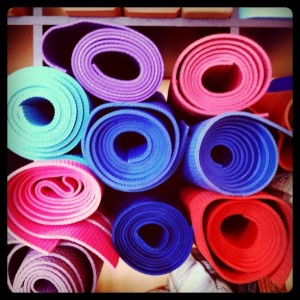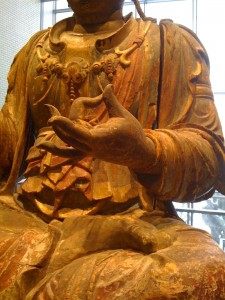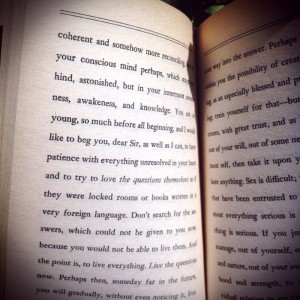“Peace is always beautiful.” ~Walt Whitman
No integrated class on Sunday, December 28, at the OM collective. We gather again on Sunday, January 4. Best wishes for a peace-filled New Year celebration.

The always-lovely OM collective is moving locations, and so will we!
Starting May 4, the Sunday morning integrated practice will take place a few blocks north at the new studio at 515 West Lake Street, on the southeast corner of Lake and Garfield. There’s a parking lot (yay!) and lots of street parking (yay!). Please join us May 4—and every Sunday.
The great Shankaracharya says that everyone is ananda. Being of bliss … ananda, purnam, completeness, bliss, totality of bliss. … All the pleasures of the world are little sparks of the fire of ananda. All the pleasures of the world are just drops in the ocean of ananda, and every drop is trying to experience what it feels like to be the whole ocean. Every drop that is you and I, every drop is trying to feel, trying to see what it would be like to be the whole ocean of that joy and bliss. ~Swami Veda Bharati, “Yoga Nidra Refined Silence“
 Join me for two new class series:
Join me for two new class series:
Hatha: Combined I and II starting January 4
Meditation III: Mantra, the Key to Deeper Meditation starting January 8
Check out my classes page for details.

Swami Rama Sadhaka Grama ashram in Rishikesh, India.
The trip is a long one. The culture shock can initially be, well, shocking. And you may have to share the road on the way with cows, monkeys, and the occasional elephant. But a pilgrimage to the peace-filled and profoundly nurturing Swami Rama Sadhaka Grama at the foothills of the Himalayas is worth any strain that it might take to get there. I’ve visited twice—each a transformational visit—and recommend its beauty (physical, spiritual, and social) beyond question, whether for a personal retreat or for unique training in hatha, meditation, and the other Yoga sciences as taught by the Himalayan Yoga tradition.
The next teacher training session is in November. For more info, email Maryon at hyt.ttp@gmail.com or read about the Himalayan Yoga Tradition Teacher Training Program here.
And when you have a minute, take a peek at a video of this amazing place.
On Thursday, September 12, join me as I sub for the amazing Ali Certain and offer a gentle hatha class with guided relaxation and seated meditation at the OM collective from 6:30 – 8:00 pm. Bring a meditation cushion if you have one, but come even if you don’t.
Two more weeks are left in Hatha I on Tuesdays from 6:30 – 8:00 pm at the Meditation Center in NE Minneapolis. Drop-ins are welcome for this stimulating yet restorative practice.
Check out the classes page to read about “Meditation III: Mantra, the Key to Deeper Meditation.” Class starts September 30! Feel free to be in touch with any questions.
 Typically, I don’t watch much television. But like many people, I find the Olympic Games irresistible. The speed of well-trained minds, the physical grace of strong, practiced bodies, the nearly palpable power of concentration… unathletic me finds it awe inspiring. So I made a trip to Radio Shack, untangled a mess of cords, and plugged and unplugged connectors from boxes until London appeared on the screen. Then Fleur the Cat and I settled in.
Typically, I don’t watch much television. But like many people, I find the Olympic Games irresistible. The speed of well-trained minds, the physical grace of strong, practiced bodies, the nearly palpable power of concentration… unathletic me finds it awe inspiring. So I made a trip to Radio Shack, untangled a mess of cords, and plugged and unplugged connectors from boxes until London appeared on the screen. Then Fleur the Cat and I settled in.
Of course, along with the freestyle relays, the beach volleyball matches, the road races, and the skeet shooting come the commercials. I don’t hate commercials; in fact, I admire good ones (and, I must also admit, all too often cry at sappy ones), since part of what I do for a living is write advertising and branding copy. So when I watch, I pay attention. And one commercial running during this summer’s broadcasts kept my attention.
Nike’s “Find Your Greatness” is beautifully filmed, but it was the message that made me search the Internet when the one-minute spot ended. In a nutshell, the gist is this: Somehow, for some reason, we think that greatness is reserved for the gifted, talented, rare few. But greatness doesn’t lie in wait for special people. Greatness is wherever someone is trying to find it.
Greatness is in the trying. It is in the practice. It is in the seeking. This set me to thinking… in my life, trying for what? Practicing for what? Seeking what? And the first answer that popped into my head was this: the experience of wholeness.
It seems so easy for so many of us to see ourselves and to feel ourselves as lacking, as insufficient, as not quite able, or in some way or another as less than. Yoga philosophy promises that at our core, we are always already whole, lacking nothing. But in reality, we just don’t always (if ever) feel it or we just don’t (or won’t) believe it. Nevertheless, yoga science, through things like the eight limbs of Patanjali’s Yoga Sutras, provides “maps” for those of us willing to put doubt aside and take the chance that yogis across the centuries might just have been right.
Such yogis embraced sadhana to find their greatness. The Sanskrit term sadhana is often used to mean self-effort and the discipline necessary for sticking to a program of spiritual advancement. It is from the verb-root sadh, which means to go straight to the goal, just as Olympic athletes, gathered to compete in the games, go straight for the goal.
The master teacher of a number of my own teachers said this about sadhana:
The process in which the aspirant unfolds, develops, and enlightens himself [sic] is called sadhana. Sadhana is the practice which has the power to carry the seeker (sadhaka) to his objective. The object is to realize the truth of life. We have to bring about our maximum development and arouse and express the power lying dormant within us. It is possible through sadhana alone…. Our goal is to attain absolute peace, an unalloyed happiness or perennial bliss; and this is possible only when we use all circumstances in life, whether good or bad, happy or painful, to promote our sadhana. All circumstances in life cannot be made to suit us, but continuous sadhana makes us feel that the condition which is hostile to us at present, is in fact an opportunity for advancement on the path (Swami Rama, Book of Wisdom: Ishopanishad).
The experience of wholeness (of absolute peace and unalloyed happiness) is possible, so say those great sadhakas who have, through practice, seeking, and trying, found their greatness. And what heartens me is that all aspects of a complex, modern life—the joys and losses, the gifts and griefs—play an integral part.
Feeling whole is not reserved for those with the luxury of taking daily hatha classes or going on three-month-long retreats in sacred places. It is not the privilege of ancient ascetics who sought the silence of meditation caves high in imposing mountains. It is for all of us. My own experience of that wholeness lies in my choosing to live my life, with all it brings me, in a certain way, a way inspired by the wisdom of yoga, a way that is everyday seeking, step by step, and everyday greatness.
 There is so much in the work of the late nineteenth-century, early twentieth-century German poet Rainer Maria Rilke that I find astonishing—that cracks open my everyday perspective, simply and powerfully. Some of his most accessible and moving (and now very well-known) words are in his letters to Franz Xaver Kappus, a young military student who was embarking on a career he wasn’t sure he wanted when he sent the famous poet a letter of introduction and a few pages of his own poetry. In one of his letters back to Kappus, Rilke writes,
There is so much in the work of the late nineteenth-century, early twentieth-century German poet Rainer Maria Rilke that I find astonishing—that cracks open my everyday perspective, simply and powerfully. Some of his most accessible and moving (and now very well-known) words are in his letters to Franz Xaver Kappus, a young military student who was embarking on a career he wasn’t sure he wanted when he sent the famous poet a letter of introduction and a few pages of his own poetry. In one of his letters back to Kappus, Rilke writes,
You are so young, so much before all beginning, and I would like to beg you, dear Sir, as well as I can, to have patience with everything unresolved in your heart and to try to love the questions themselves as if they were locked rooms or books written in a very foreign language. Don’t search for the answers, which could not be given to you now, because you would not be able to live them. And the point is, to live everything. Live the questions now. Perhaps then, someday far in the future, you will gradually, without even noticing it, live your way into the answer. (Rilke, Letters to a Young Poet, trans. Stephen Mitchell)
So again, here’s patience—with the mystery of our most unresolved, anguished questions, those lodged in our hearts as if locked in rooms or as if lying just beyond our comprehension on the pages of a seemingly (very) untranslatable book. Clearly knowing the discomfort of holding those questions himself, the poet gently advises his young friend to try to love them. Not to love them, but to simply try. And then to wait, maybe for a really, really long time, for the answers to become visible, tangible, livable.
For Rilke, the waiting erupted into poetry.
One of the biggest challenges for me in my practice of yoga has been that, when it comes down to it, the learning‚ the discovery, and the baby-step-by-baby-step resolutions are all essentially and fundamentally experiential. For an ex-academic inclined to hoard reference materials and to do impressive amounts of research before embarking on just about anything, this is a huge deal.
And this is why Rilke’s advice moves me, and why it is so important for me. Every time I close my eyes before meditation practice or move into an asana or slow and deepen my breath in pranayama, I am struck (I swear it often feels physical) by how “so much before all beginning” I am, especially in the face of the enormity of my endeavor and its importance. The practice and the reason for the practice are everything, and it is often like stepping into darkness; I cannot see where I am going. How I respond is my choice: I can turn back, I can fume, I can give into doubt, uncertainty, or fear, or I can present my questioning self, do what I know, wait, and cultivate patience. It’s not easy; I am waiting to “come into” the answer of the meaning of my existence—or more accurately, I am waiting for the answer to come into me, living in the urgency of the question, trusting that the answer will come, probably piece by piece, when my practice has prepared me to live it. And I don’t know when this will be.
Yoga philosophy, of course, promises that each of us already has the answers and they comes to us from within. So perhaps I should say that I wait for the answers to emerge into my self-awareness, to crack that perspective open so that I live everything even more fully than with the questions alone, as more of who I truly am.
If all of this is too heady, or all of this stuff about patience and waiting and emerging self-awareness just too wearing, we can come back to the things that the practice gives us as we do it. When it comes to meditation, the ongoing fruits are something like these (in the words of a master yogi and teacher):
Meditation will give you a tranquil mind. Meditation will give you awareness of the reality deep within. Meditation will make you fearless; meditation will make you calm; meditation will make you gentle; meditation will make you loving; meditation will give you freedom from fear; meditation will lead you to the state of inner joy called samadhi. These are the results of meditation. If you understand these goals and want to meditate, then it will help you… (Swami Rama, The Art of Joyful Living)
Rilke says in yet another letter, “What is happening in your innermost self is worthy of your entire love.” All the practice, the sitting with the questions, the trying to love them, the failing or the not failing . . . all of it is worthy of our deepest devotion—every drop of it. For each of us is, after all, so worth being, and so worth waiting for.